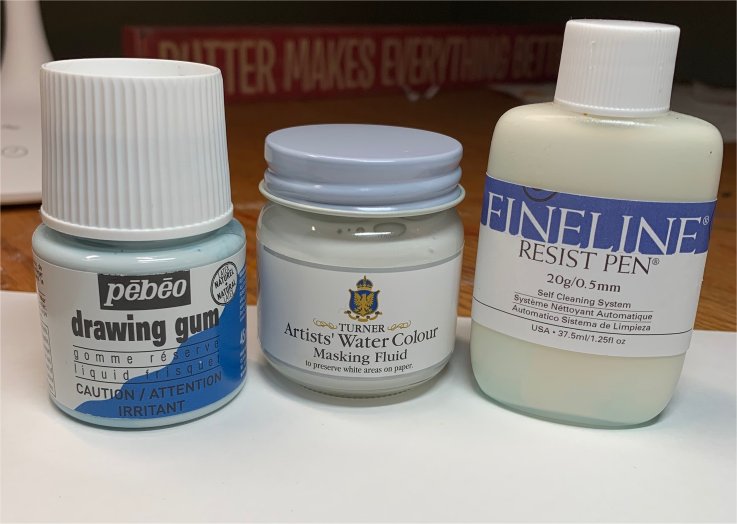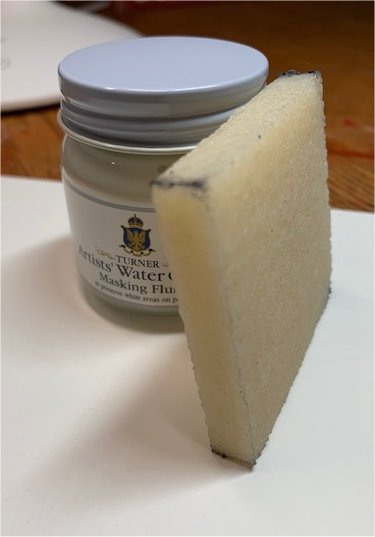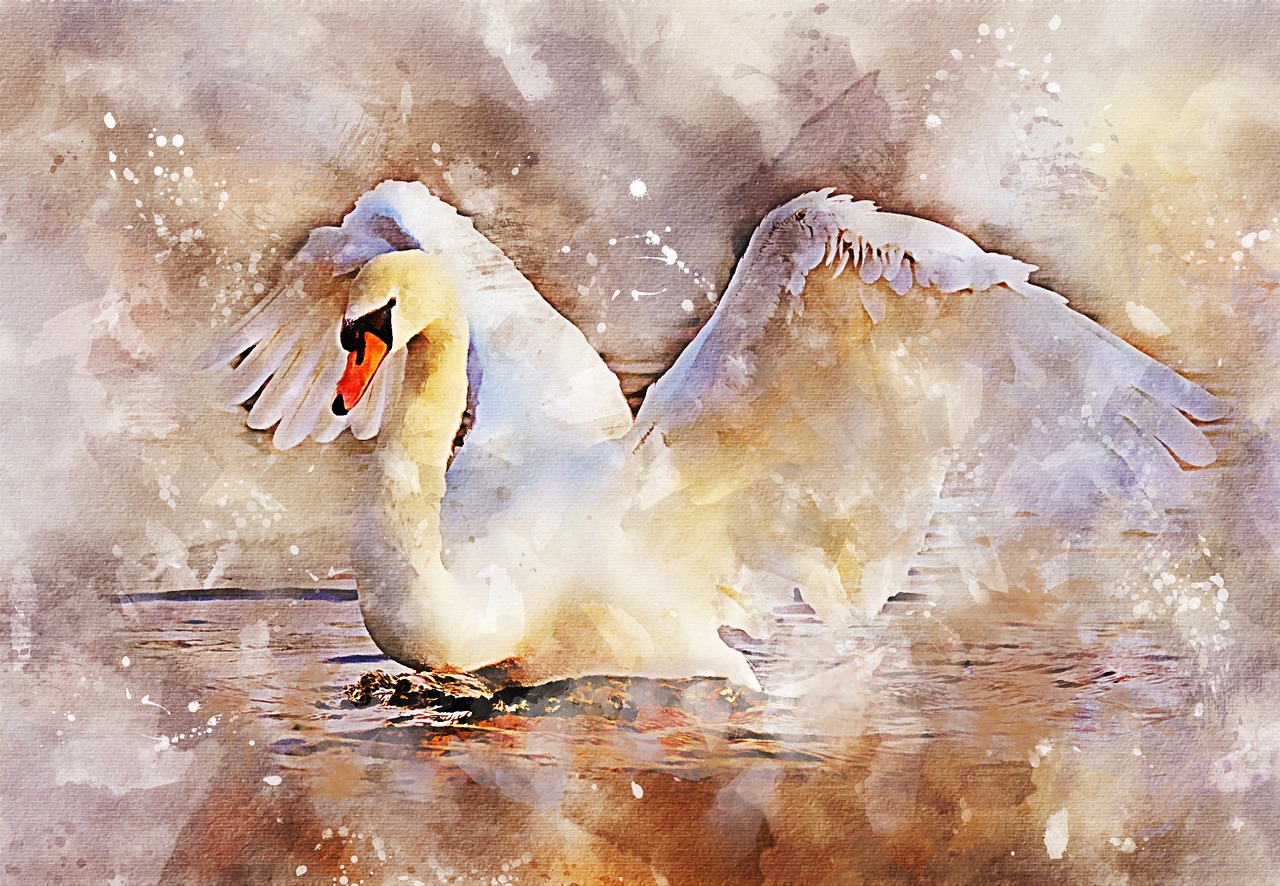Masking Fluid: Good, Bad and Ugly
Masking fluid products are supposed to help watercolor artists create stunning light and shadow effects in paintings, but many artists have trouble using them.
Artists use these products to protect the watercolor paper in areas that should stay white. Once these areas are masked, the artist can apply broad, continuous washes of color across a painting without losing the areas that should stay white or light in color. Here's an example of a painting that most likely used masking fluid. The white paper along the wing edges and the white spatters contrast sharply with the continuous background of color washes and shadows.
What is Masking Fluid?
Masking fluid is also called liquid frisket, or drawing gum. These fluids are basically liquid latex. When the fluid is applied to watercolor paper, the latex stops the flow of paint to the masked area.

There are many different brands, with some being colored so you can see where you applied it, and others are white upon application but clear when dry.
Masking Fluid is NOT Masking Medium
Masking fluid is not the same product as masking medium. Masking medium does basically the same thing, as it resists paint on watercolor paper. But masking medium is a permanent addition to the painting. In fact, it can be added to watercolor paint to cause the applied paint itself resist new washes of color.
In contrast, masking fluid is used to temporarily protect watercolor paper from paint. It must be removed from the paper within 24-48 hours, or it will leave a gummy residue and can damage the paper.
How is Masking Fluid Applied?
Masking fluid can be applied in many different ways. You can paint it on, or splatter it , or draw fine lines. The tools to apply it will limit what you can do:
- Regular watercolor paint brush: Don't use a good brush! Masking fluid cannot be removed from brush hairs, so use a junk brush. Some artists keep a bar of soap to coat and protect the wet brush before dipping it into the fluid. I don't recommend using a brush; I tried and ended up having to pitch the brush.
- Silicone applicator tools: these are great because you can just rub the masking fluid off of them when you are done. I bought the fine point set in the picture from Amazon.
- Calligraphy or ruling pen: think of the kind old-timers would dip in ink. These are great because you can apply the masking fluid finely to protect very thin lines and details in your painting.
- Other possible tools I've seen artists use include a bamboo stick with a sharp point, toothpicks or a cocktail appetizer stick with an arrow point.
Once you have a tool and are ready to apply it, make sure you keep these rules and tips in mind:
- The paper to which you are going to apply it has to be completely dry. If you apply masking fluid to wet or damp paper, it will soak into the paper fibers and be impossible to remove.
- Once you apply it, don't paint over it until it is completely dry. And don't use a hair dryer to speed the drying process. Heating it will make it very hard to remove.
- The type of paper you are using will make a difference. Some papers will tend to grab it more than others, so you might want to do some tests first.
- As mentioned above, if you want to avoid a possible stain from a colored masking fluid, do some tests firsts on the paper.
- You can thin masking fluid with a little water or ammonia.
- Don't leave it on the paper for more than 24-48 hours.
- Instead of having to go back to the product bottle, put some on your palette and use it from there. That way you aren't drying out the rest of the product by keeping the bottle open.
Removing Masking Fluid
 Rubber Cement Pickup
Rubber Cement PickupThere are several methods for removing masking fluid. The first thing to remember is that the paper MUST be completely dry before you start to remove it. I ruined a beautiful little bird painting because I hadn't learned this yet. I went to rub off the masking fluid and ripped a strip of paper right off with it. Grrrr.
But if the painting and the fluid are very dry, you can just rub the dried masking fluid off with your fingers. I don't recommend this because it can cause sore fingers, and I think the heat and oil on your fingers might cause some issues too.
Many artists use a rubber cement pickup square like the one in the picture. One ingenious artist named Kory Fluckiger paints an extra penny-sized circle of masking fluid, and then rubs the dried result into a little log that he uses to remove the rest.
Alternatives to Masking Fluid
The following products can be used in place of masking fluid to protect your watercolor paper:
- Masking film, aka frisket film
- Masking tape and a sharp knife
I haven't tried any of these alternative methods but if you google them, there are videos out there. One of my favorite artists uses masking tape to protect her paintings and has made a video about her process here:
You'll notice that I did not mention wax medium or wax resist in the alternative choices list above. Although these products do protect the watercolor paper, they are permanent additions, and can't be removed easily.
Brands: What to buy?
The best answer to this question is to watch a video on Youtube in which a Canadian artist tests 20 different masking fluid products in many different ways. It's long but entertaining to watch. She gives you her recommendations for bottle based brands at about 23:50. There are also masking fluid pens and tip applicators and she reviews those after the bottle products, and provides her thoughts at the end.
My final observation is that I can tell you from experience that the Fineline products she reviews are useless. I've bought both and the fine tips clogged and were useless after using the product only once or twice. Waste of $15, in my opinion.
So that's my take on masking fluid. If you have any questions, send me a message from my contact page. I'll do my best to answer them.
